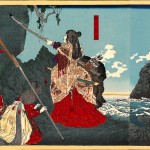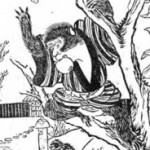Watching the Smithsonian program, “Samurai Warrior Queens,” I found myself, again, marveling at how anonymous the historians (?mostly male) kept women’s contributions — anonymous. I am reading the kokinshū for the sequel to Pillow Book of the Flower Samurai, which I am currently calling The Samurai’s Daughter. The kokinshū is a massive Imperial collection of poetry from the early 10th century. And the translators/authors of this fabulous book speak of this very thing. The anonymity of women and their contributions. In the kokinshū many of the poems’… Continue reading →
Category Archives: Heian Japan
New Year, Old Thoughts

I want to share with you a line from one of my poems: Sexism is the last racism What do I mean by this? Sexism has proved itself to be the last bastion of prejudice. From the first question we ask when babies are born, “boy or girl?” to the language we speak, the way we act (which for my money is also language), to legal and political rights and privileges. This is every country, every nation, everywhere. male forms If you’re questioning this, good.… Continue reading →
#1 In Historical Fiction—ACCURACY!

There are four characteristics I value in historical fiction. I’ll be talking about each one in the next few posts. 1. Most important for me is ACCURACY. I truly like the facts to be correct. For example, I noticed that Harlequin Romances was advertising for historical romance. Great. I know a little (okay, a lot) about the late Heian period. BUT. But, I am familiar with their standards. The way the romances are supposed to go—is nowhere near the path the romances of the Heian… Continue reading →
PERSISTENCE

The Japanese, especially in the Heian period and perhaps later, world we would call superstitious. Like Western Europeans they believe that illness could be caused by “bad spirits” and that their minute actions could cause disastrous consequences not only for themselves but for others. Naturally they would turn to the Seven Gods of Luck, displayed above and below. As I write this I take out a special package friend of mine gave me in which I keep buttons. But these buttons have the faces of… Continue reading →
The Bow and Arrow: Another Weapon Also Used by Women
The bow and arrow provided the majority of weaponry in Heian and early Kamakura Japan. the predominance of the sword did not actually come “into” use, although it was used, until later. The actual ascendancy of the bow and arrow began during the wars before and the Genpei War. Shooting the bow and arrow became, like most of the arts in Japan, an elaborate and systematic process which required much practice. There are actually eight named stages of shooting an arrow: 1.ASHIBUMI (footing) 2. DOZUKURI… Continue reading →
Women’s Weapons: The Naginata
Between the 12th and approximately the 15th centuries women defended themselves, their families and their homes. They concealed daggers in their sleeves or sashes and delivered their deadly blades with great accuracy. Women also used the naginata, which is a pole having a long, curved sword at the top. For an ambush, women swung naginata in narrowed places, cutting the legs of horses to disable the enemy soldiers. Sometimes women fought alongside their husbands in battle. And they were expected to commit seppuku (ritual suicide)… Continue reading →
HISTORICAL FACT FROM HISTORICAL FICTION

One of the things I love about historical fiction is that I am able to learn about the historical time, people and events. So — who were the real people and who are fictional characters in Pillow Book of the Flower Samurai? Kozaishō and all of the Taira: Michimori, his family members, and even his ‘sidekick’, Tokikazu,were real. The Retired Emperor Go-Shirakawa and Antoku did live as well. As did the Minamoto: Yoshitsune, Yoritomo, Yoshitomo, Yoshinaka, Noriyori, and Yukiie. Kozaishō’s family, Akio, Toshiko, the girls on the… Continue reading →
Real Female Samurai
WERE THERE REAL SAMURAI? * * * The answer is YES! Definitely yes. Was Kozaishō a real samurai? She did really exist. She was the wife of the commander-in-chief Taira no Michimori, and according to Tale of the Heike, she was at the battle of Ichinotani. However, also with reference to the Tale of the Heike, she probably was nota samurai, but she could have been. * * * The first strong evidence of a real warrior woman is Empress Jingu who was married to… Continue reading →
More Tales and Superstitions

How We Tell Time – in Ancient Japan with the Zodiac I thought you might enjoy reading (or reading again) the story that is told to Kozaishō who learns the twelve animals of them: One day, the Emperor of Jade, the God of the heaven, declared to all the animals that he was going to choose twelve of them to name the years. The first twelve who arrived at his palace would each have the task of protecting mankind for one year. All the animals… Continue reading →
Superstitions and Tales

Superstitions and Tales There was an old belief that persimmons have magical powers that bring the birth of children and a good harvest. Incidentally, there is a Japanese saying, “Saru mo ki kara ochiru.” This means, “Even monkeys fall out of trees,” or as the English expression has it, “Pride comes before a fall.” Once upon a time there was a crab who picked up a rice cake, and a monkey, who had a hard persimmon-seed, came together, and who begged the crab to exchange… Continue reading →